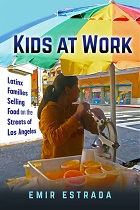Kids at Work: Latinx Families Selling Food on the Streets of Los Angeles

According to its introduction, Kids at Work “is the first book to look at the participation of child street vendors in the United States” (page 3). These children are often US citizens working with their undocumented Mexican or Central American parents, selling tamales, cold drinks, and other food from mobile carts or prams. There are over 50,000 street vendors in Los Angeles.
The analysis of both migration policy and individual stories shows that for the majority of interviewees, informal street vending was a last-resort occupation in LA, rather than the job that they or their parents had been doing continuously in multiple countries. As Estrada explains, “The children in this book must take an active role in family reproduction activities because their own labor contributions are what make it possible for their families to survive the structural economic and employment barriers they face in the lower sector of the economy…They are the Latinx youth who are growing up in households where parents have less or no access to jobs that are safe, unionized, and offering a living wage.” (pages 16–17) The contributions of the children include English fluency, documented status and social media savvy – all part of what Estrada calls “American generational resources”. These resources make street-vending children valuable contributors to family businesses, rather than simply readily available sources of labour.
Despite these valuable contributions, Estrada’s young interviewees describe being name-called and stigmatized for their involvement in informal, poorly understood work. Yet many remain proud of their work ethic and support to their families, and angry at the police harassment that could lead to the deportation of the loved ones. Eighteen-year-old Veronica, who has been selling sliced fruit with her mother for six years, says that her friends “were making fun of me, and they tell me that I’m right here in the street, like a Mexican person selling in the streets. People tell me, “Ha! You’re a wetback!” . . . I wanted to cry because they were making fun on me, but then I got over it.” (page 32)
These young interviewees are predominantly girls, reflecting both the gendered distribution of domestic and food-based work, and gendered notions of appropriate behaviour. Interestingly, in high-crime areas of L.A., the families Estrada interviews sometimes comment that it is safer for girls to be on the streets vending, compared to adolescent boys who could become targeted for gang violence.
The focus on participant observation means that Estrada is sitting down for meals with vendors, meeting them for early-morning setup, and witnessing their interactions with customers and law enforcement. All this observation leads her to conclude that street vending in L.A. is “a cultural economic innovation born out of need and ingenuity” (page 63) that also showcases the city’s inequality, as “the same people and culture can be celebrated, commodified, and systematically rejected in one place and time” (page 52).
Further reading:
Rodas, Clara (2018), “California Gov. Jerry Brown signs law decriminalizing street vending”, Daily Californian, 20 September, available at https://www.dailycal.org/2018/09/20/california-gov-jerry-brown-signs-law-decriminalizing-street-vending/.
Roever, Sally and Caroline Skinner (2016), “Street vendors and cities”, Environment and Urbanization Vol 28, No 2, pages 359–374, available at https://journals.sagepub.com/doi/full/10.1177/0956247816653898.
Rosales, Rocio (2011), “Survival, economic mobility and community among Los Angeles street vendors”, Journal of Ethnic and Migration Studies Vol 39, No 5, pages 697–717, available at https://ccis.ucsd.edu/_files/journals/36survival-economic-mobility-and-community-among-los-angeles-fruit-vendors1.pdf.
Search the Book notes database
Our Book notes database contains details and summaries of all the publications included in Book notes since 1993 - with details on how to obtain/download.
Use the search form above, or visit the Book notes landing page for more options and latest content.
For a searchable database for papers in Environment and Urbanization, go to http://eau.sagepub.com/

